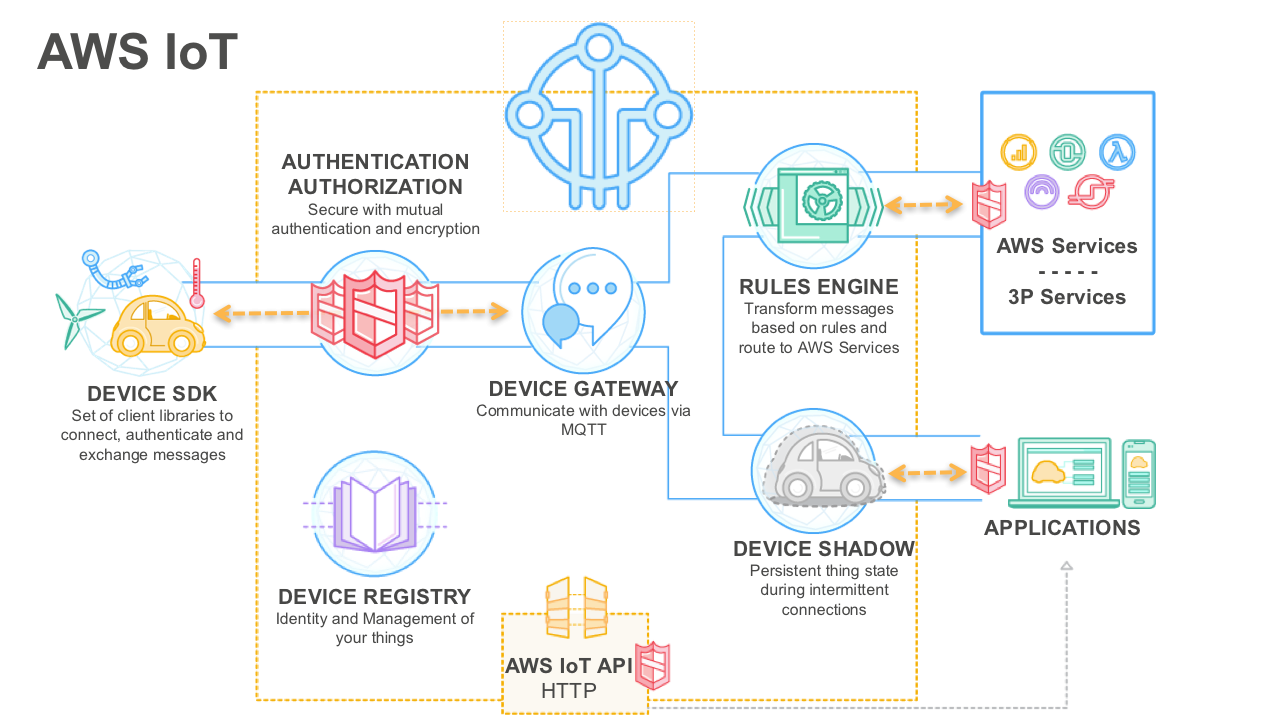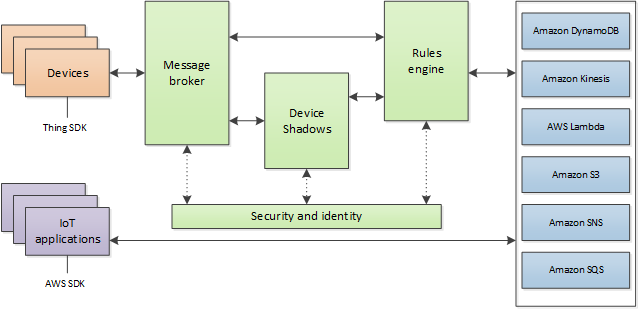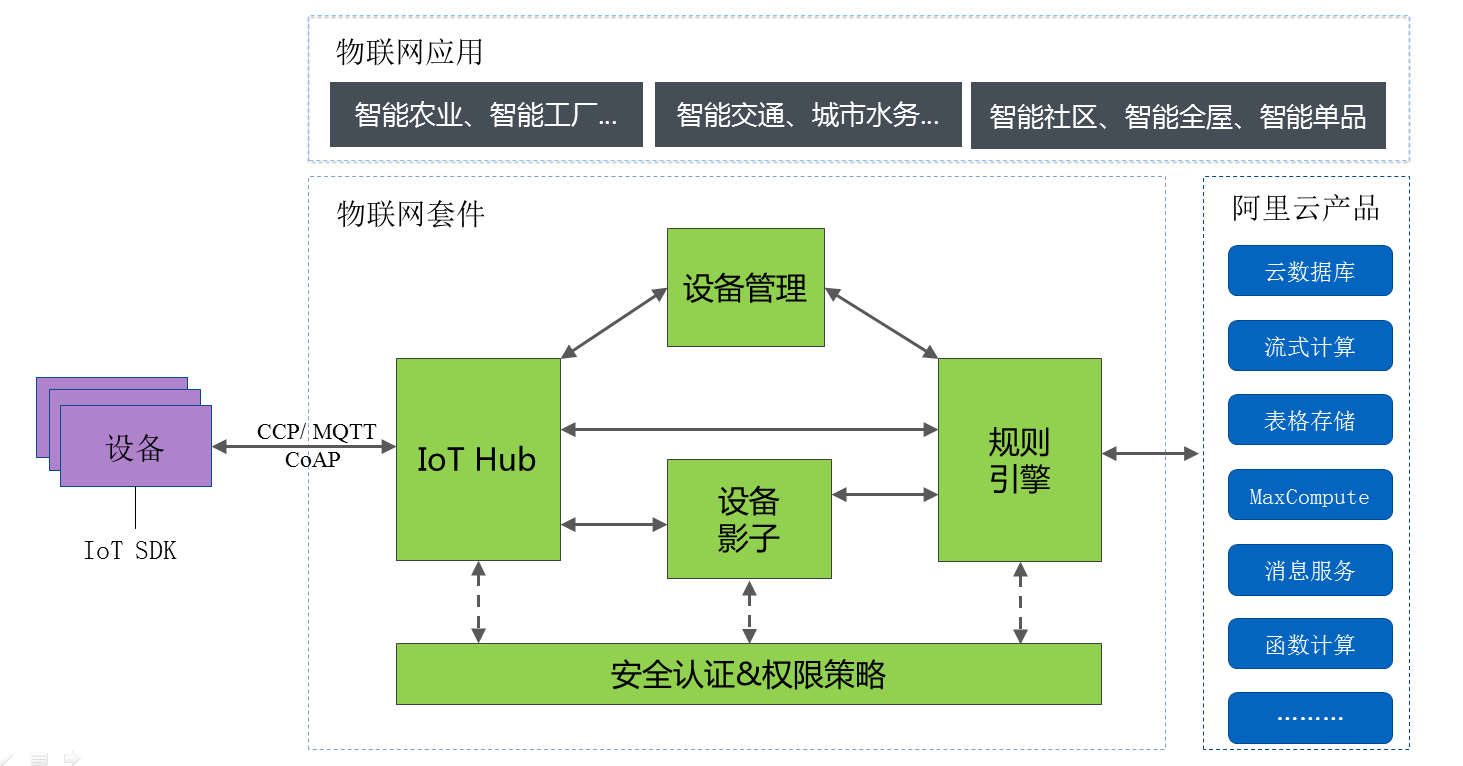AWS IoT
去年调研了所有的IoT平台,最后总结只有两家,分别是:AWS IoT和其他IoT。本文从AWS IoT Document中摘取核心功能和特点进行说明。
1 IoT是什么?
IOT能够提供在设备与云端进行安全的双向通信的能力,可以进行数据的远程采集、分析、存储,并可以进行设备的远程控制。
2 功能组件
3 组件介绍
3.1 安全与认证
3.1.1 原理
任何设备都必要拥有证书才能访问Broker,所有经过IOT的数据都使用TLS进行加密。IOT基于标准的TLS协议进行设备和云端双向认证来验证双方的身份。 设备需要将包含私钥的证书埋在安全可靠的地方,并且每个设备拥有唯一的证书,云端使用对应的公钥进行验证。 设备也需要将AWS的根证书加入本地可信任证书列表中,用来验证云端的身份。
3.1.2 证书生成方式
证书可以在AWS控制台直接生成,也可以通过命令行,以及RESTful API进行生成。
https://docs.aws.amazon.com/cli/latest/reference/iot/create-keys-and-certificate.html
https://docs.aws.amazon.com/iot/latest/apireference/API_CreateKeysAndCertificate.html
3.1.3 授权策略
IOT授权策略使用与IAM相同的规范进行管理,通过将设备唯一标识或组与策略进行关联实现权限的控制。举例如下:
{
"Version": "2012-10-17",
"Statement": [{
"Effect": "Allow",
"Action":["iot:Publish"],
"Resource": ["arn:aws:iot:us-east-1:123456789012:/topic/foo/bar"]
},
{
"Effect": "Allow",
"Action": ["iot:Connect"],
"Resource": ["*"]
}]
}解释: 版本2012-10-17 允许进行发布到 us-east-1 区 topic/foo/bar 队列,同时允许连接到任何Broker。
策略列表: https://docs.aws.amazon.com/iot/latest/developerguide/action-resources.html
Action
Resource
iot:DeleteThingShadow
A thing ARN - arn:aws:iot:us-east-1:123456789012:thing/thingOne
iot:Connect
A client ID ARN - arn:aws:iot:us-east1:123456789012:client/myClientId
iot:Publish
A topic ARN - arn:aws:iot:us-east-1:123456789012:topic/myTopicName
iot:Subscribe
A topic filter ARN - arn:aws:iot:us-east-1:123456789012:topicfilter/myTopicFilter
iot:Receive
A topic ARN - arn:aws:iot:us-east-1:123456789012:topic/myTopicName
iot:UpdateThingShadow
A thing ARN - arn:aws:iot:us-east-1:123456789012:thing/thingOne
3.2 Message Broker
3.2.1 功能
Message Broker允许Client向某个Topic发送消息,订阅一个或多个Topic。Broker保存所有连接信息及订阅信息(这里介绍不清楚,直接影响到实现方式:所有连接信息是指当前broker上的所有连接,还是整个Broker集群的所有连接信息)。
3.2.2 协议
3.2.2.1 端口映射
| Protocol | Authentication | Port |
|---|---|---|
| MQTT | Client Certificate | 8883 |
| HTTP | Client Certificate | 8443 |
| HTTPS | SigV4 | 443 |
| MQTT + WebSocket | SigV4 | 443 |
3.2.2.2 MQTT
AWS IOT没有完全实现MQTT协议 aws protocols 不支持QoS2; 不支持Retained消息; 不支持session持久化存储; …
3.2.3 Topics
Topic用来在设备和云端之间路由消息。 /用来对topic进行分层。 $表示保留topic。
https://docs.aws.amazon.com/iot/latest/developerguide/topics.html
通配符功能如下:
Wildcard
Description#
Must be the last character in the topic to which you are subscribing. Works as a wildcard by matching the current tree and all subtrees. For example, a subscription to Sensor/# will receive messages published to Sensor/,Sensor/temp, Sensor/temp/room1, but not the messages published to Sensor.+
Matches exactly one item in the topic hierarchy. For example, a subscription to Sensor/+/room1 will receive messages published to Sensor/temp/room1, Sensor/moisture/room1, and so on.
3.2.4 事件
https://docs.aws.amazon.com/iot/latest/developerguide/life-cycle-events.html
客户端建立连接时,IOT向如下topic发送事件,业务可以监听此topic获取通知: $aws/events/presence/connected/clientId 对应内容:
{
"clientId": "a1b2c3d4e5f6a7b8c9d0e1f2a3b4c5d6",
"timestamp": 1460065214626,
"eventType": "connected",
"sessionIdentifier": "00000000-0000-0000-0000-000000000000",
"principalIdentifier": "000000000000/ABCDEFGHIJKLMNOPQRSTU:some-user/ABCDEFGHIJKLMNOPQRSTU:some-user"
}连接断开时,对应的topic如下:$aws/events/presence/disconnected/_clientId_
订阅topic时:$aws/events/subscriptions/subscribed/_clientId_
取消订阅时:$aws/events/subscriptions/unsubscribed/_clientId_
3.3 影子服务
3.3.1 定义
设备影子是一个json串用来存储和检索设备的当前状态。
3.3.2 功能
AWS IOT提供的三个方法来操作影子服务
UPDATE:更新影子服务的状态,如果目标不存在就直接创建。
GET:获取设备在影子服务中最新的快照。
DELETE:删除设备对应的影子。
https://docs.aws.amazon.com/iot/latest/developerguide/thing-shadow-rest-api.html
3.3.3 影子JSON内容
HTTP GET https://endpoint/things/thingName/shadow
{
"state": {
"desired": {
"lights": {
"color": "RED"
},
"engine": "ON"
},
"reported": {
"lights": {
"color": "GREEN"
},
"engine": "ON"
},
"delta": {
"lights": {
"color": "RED"
}
}
},
"metadata": {
"desired": {
"lights": {
"color": {
"timestamp": 123456
},
}
"engine": {
"timestamp": 123456
}
},
"reported": {
"lights": {
"color": {
"timestamp": 789012
}
},
"engine": {
"timestamp": 789012
}
},
"delta": {
"lights": {
"color": {
"timestamp": 123456
}
}
}
},
"version": 10,
"timestamp": 123456789
}3.4 规则引擎
3.4.1 定义
规则引擎提供一种将设备和云服务关联起来的能力。规则引擎基于mqtt topic stream来工作的。
3.4.2 功能
过滤来自某一个设备的数据。 将数据路由到DynamoDB。 将数据保存到S3。 将数据路由到SQS。 将数据录入Elastic Search服务。 将数据路由到Amazon ML服务基于模型进行分析。 …
3.4.3 例子
将目标为Topic ‘iot/test’ 的所有消息路由到名称为my-dynamodb-table的表中。
{
"sql": "SELECT * FROM 'iot/test'",
"ruleDisabled": false,
"awsIotSqlVersion": "2016-03-23",
"actions": [{
"dynamoDB": {
"tableName": "my-dynamodb-table",
"roleArn": "arn:aws:iam::123456789012:role/my-iot-role",
"hashKeyField": "topic",
"hashKeyValue": "${topic(2)}",
"rangeKeyField": "timestamp",
"rangeKeyValue": "${timestamp()}"
}
}]
}
``
将目标为Topic ‘some/topic’的所有消息路由到my_sqs_queue的队列中。
```json
{
"rule": {
"sql": "SELECT * FROM 'some/topic'",
"ruleDisabled": false,
"actions": [{
"sqs": {
"queueUrl": "https://sqs.us-east-2.amazonaws.com/123456789012/my_sqs_queue",
"roleArn": "arn:aws:iam::123456789012:role/aws_iot_sqs",
"useBase64": false
}
}]
}
}3.5 监控
3.5.1 说明
监控是IOT服务的重要组成部分,用来监测服务的稳定性、可用性、性能。
3.5.2 提出问题
AWS IoT没有指明监控如何实现,但是提出了设计监控时应当考虑的问题,挺专业的)_ 监控的目标是什么? 监控那些资源? 监控的频率是多长时间? 使用什么监控工具? 谁来执行监控任务? 当监控到错误时,由谁来处理?
https://docs.aws.amazon.com/iot/latest/developerguide/monitoring_overview.html
4 费用
4.1 计费
单连接每百万分钟$0.08; Broker每百万条消息$1.00; 影子服务每百万次操作$1.25; 规则引擎每百万次操作$0.15; SQS每百万条消息$0.40;
4.2 举例
以美西区为例,一百万辆车,每分钟上报两条数据,忽略(车控指令产生的费用,读取影子服务产生的费用)经过规则引擎路由到SQS计算一年中费用: 一百万辆车保持一年长连接:0.08 * 60 * 24 * 365 一百万辆车每辆车每分钟上报两条车辆状态(↑128k):1 * 2 * 60 * 24 * 365 一百万辆车每辆车每分钟更新两次影子服务:1.25 * 2 * 60 * 24 * 365 一百万辆车每辆车每分钟触发两次规则引擎,并执行规则(触发和执行分别计费):0.15 * 2 * 2 * 60 * 24 * 365 一百万辆车每辆车每分钟写两条消息到SQS(消费端读单独计费):0.4 * 2 * 2 * 60 * 24 * 365 乘以6.4汇率,一百万辆车一年的保守费用:(0.08 + 12 + 1.252 + 0.1522 + 0.422) * 60 * 24 * 365 * 6.4 = 22,806,836人民币。
5 缺点
5.1 只能通过日志查看消息的投递状态 5.2 对接依然需要较高开发成本


